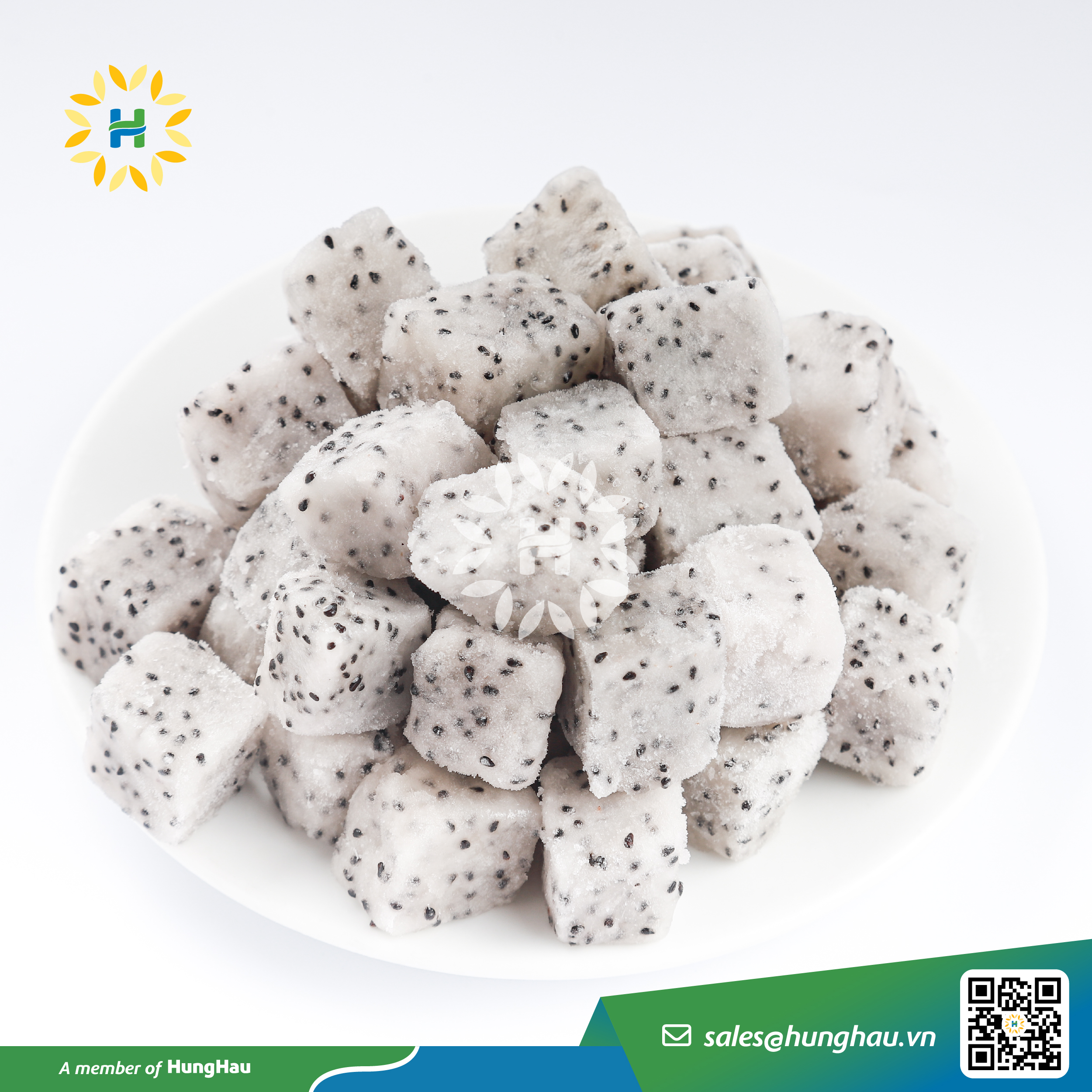Featured News, Market News, News & Event
VIETNAMESE IQF DRAGON FRUIT: EXPORT POTENTIAL AND SUPERIOR QUALITY
Vietnam’s frozen dragon fruit is steadily solidifying its strong position in the global agricultural export industry, thanks to its superior quality and modern processing technology. Particularly, with the growing trend of ready-to-eat food, frozen fruit is becoming a popular choice worldwide. In this article, we will explore the strengths of Vietnam’s frozen dragon fruit, its export potential, and why this fruit is capturing the attention of international markets.
Dragon fruit is a tropical fruit beloved worldwide for its delicious flavor, vibrant color, and health benefits. Vietnamese dragon fruit stands out due to its high nutritional content, being rich in vitamins, fiber, and antioxidants, offering numerous health benefits to consumers.
Currently, the dragon fruit market has three main varieties:
- White-fleshed dragon fruit with pink skin: Known for its refreshing taste and moderate sweetness, this variety is popular in Asian countries.
- Red-fleshed dragon fruit: Favored for its striking color and rich sweetness, this type is increasingly dominating premium markets.
-
White-fleshed dragon fruit with yellow skin: Less commonly cultivated in Vietnam.

Vietnamese dragon fruit quality: Sweetness and export standards
Vietnamese dragon fruit is highly regarded for its quality due to factors such as superior cultivars, strict production processes, and favorable tropical climate. Each type of dragon fruit meets export-standard Brix levels (sweetness):
- White-fleshed dragon fruit has a Brix level of 13-15%, perfectly suited to Asian consumers’ taste preferences.
- Red-fleshed dragon fruit has a Brix level of 15-18%, preferred in demanding markets for its rich sweetness and superior nutritional value.
Vietnam’s dragon fruit cultivation and production process also applies modern technologies such as water-saving irrigation, organic fertilization, and strict pest control, ensuring high product quality.

Premium Dragon Fruit Growing Regions
Binh Thuan, Vietnam’s dragon fruit capital, cultivates over 30,000 hectares of farmland. Its ideal climate and soil conditions yield high-quality dragon fruit that meets stringent export demands.
Beyond Binh Thuan, the Mekong Delta is another key production hub, where:
- Long An specializes in red-fleshed dragon fruit with internationally certified quality.
- Tien Giang pioneers Industry 4.0 applications in dragon fruit farming.
- Dong Thap is emerging as a promising raw material zone for the industry.
Export Potential of Frozen Dragon Fruit
Vietnam’s frozen dragon fruit is gaining global market share, leveraging advanced preservation technology and superior quality. Frozen fruit like dragon fruit is widely used in the food industry—particularly for smoothies, ice cream, and desserts—thanks to its ability to retain natural flavor and color post-thawing.
In processing, frozen dragon fruit serves as a convenient ingredient for juices, jams, and canned products, extending shelf life and enabling year-round supply.
Additionally, its high antioxidant content makes it valuable for pharmaceuticals and cosmetics, supporting health and beauty product manufacturing.
Export Outlook: By meeting high-quality standards and rising global demand, Vietnam’s frozen dragon fruit has penetrated demanding markets like Japan, South Korea, the EU, and beyond.
HungHau Foods: The Pioneer in Exporting Premium Frozen Dragon Fruit from Vietnam
Hung Hau Foods Joint stock Company (HungHau Foods) is one of Vietnam’s pioneering companies in exporting frozen dragon fruit. With a closed-loop production process from harvesting to processing and preservation, the company has successfully conquered the demanding Japanese market with its stringent quality standards.

Vietnamese Frozen Dragon Fruit by Hung Hau Foods Joint stock Company (HungHau Foods)
Hung Hau Foods Joint stock Company (HungHau Foods) produces Vietnamese frozen dragon fruit through the IQF (Individual Quick Freezing) process, helping to maximally preserve nutritional content and fresh flavor. With modern preservation technology, Hung Hau Foods’ Vietnamese frozen dragon fruit meets international standards such as GlobalGAP and HACCP, ensuring food safety for consumers.
Dragon fruit can be exported in various frozen processed forms, suitable for international market demands. Common forms include diced cubes (convenient for desserts, smoothies or salads); halved or quarter-cut (suitable for direct serving or food decoration); skewered sticks (appropriate for snacks or beverages); and pureed form (used as ingredients for juices, ice cream, confectionery, or other processed products). Thanks to processing flexibility, frozen dragon fruit not only maintains fresh flavor but also meets various usage purposes in the food and industrial sectors.
With advantages in climate, advanced farming processes and ability to meet strict international standards, frozen dragon fruit is not only a potential export product but also a versatile ingredient in the food, pharmaceutical and cosmetic industries. Companies like Hung Hau Foods Joint stock Company (HungHau Foods) have been and are paving the way for Vietnamese dragon fruit to expand globally; promising to continue being a highlight in agricultural exports, bringing high economic value and contributing to promoting Vietnamese agricultural products’ image worldwide.
IQF Red Dragon Fruit – Công ty Cổ phần Thực phẩm Hùng Hậu (Hùng Hậu Foods)
IQF Fruits & Vegetables – Công ty Cổ phần Thực phẩm Hùng Hậu (Hùng Hậu Foods)
Website: https://hfoods.vn/
Mail: sales@hunghau.vn
Phone: (+84) 98 714 0333 (Ms Hana)
Office: 642 Au Co Street, Bay Hien Ward, Ho Chi Minh City, Vietnam
